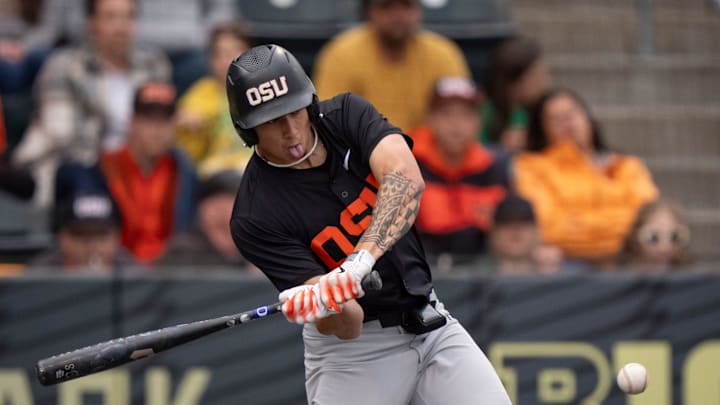If there's one thing the Pittsburgh Pirates' system needs, it's more offense. Pitching is far from the first priority heading into this summer's draft. They have very few position players in the system with a high offensive ceiling, and their multiple pitching-heavy drafts under Ben Cherington have been one of the leading reasons why their offense isn't up to par.
Adding more power to the farm system should be one of the things the Pirates target in this year's draft. Players with more offensive upside would greatly help out the system, especially college bats who won't take as long to develop as high school draft picks.
The Pirates should target these three college power hitters in the 2025 draft.
Aiva Arquette
Aiva Arquette is definitely a player the Pirates could take in the first round. MLB Pipeline recently pinned him going to the Pirates in their most recent mock draft, and he's exactly the sort of player the Pirates should be targeting. He's a well-rounded infielder who has the potential to provide power at a premium position.
Arquette is batting .350/.476/.695 through 224 plate appearances at Oregon State. This is the second season in a row he's hit at least a dozen home runs, with 16 already to his name. His isolated slugging percentage comes in just a few ticks under .350 at .345. On top of that, he's walked (14.7%) nearly as often as he's struck out (16.1%).
Arquette has the build you'd think a guy with potential 20+ home run power would have. He stands at 6'5", 220 pounds. Arquette is much larger than your typical shortstop, and has seen time at both middle infield positions and third base. He has plenty of arm strength that will play on the left side of the infield, but his average to fringe-average speed could lead to him getting moved to third base. Overall, he projects as an average defensive shortstop.
Arquette's worst tool is his hit tool. He hit well in the Cape Cod League, slashing .291/.357/.437, but carried an unimpressive 23.9% K% in a sample size of 117 plate appearances. However, MLB Pipeline still projects this as an average tool. Baseball America is slightly less bullish, putting it at 45, which is fringe-average. Either way, as long as his hit tool plays between a 45- and 50-grade level, his power will manifest in-game enough for him to be valuable
Gavin Turley
Arquette isn't the only slugger who could go early in this year's draft from Oregon State. His teammate, outfielder Gavin Turley, is another slugger the Pirates should be keeping an eye on. Turley is slashing .350/.471/.667 through 221 plate appearances. Power is the name of Turley's game, with 15 home runs already and an ISO over .300 at .315. He's also drawn plenty of free passes with a 15.8% BB%.
Turley has a high floor. His high-end raw power gives him the potential of a 20+ home run hitter. While he's not much of a base-stealing threat, he has plenty of speed and can cover ground in the outfield. His arm is a plus-grade weapon, and he can play at all three outfield positions. He also projects as an average defensive outfielder with the potential to be above-average in a corner. At the very least, that gives him the potential to be a power-hitting platoon/fourth outfielder.
However, Turley's hit tool is in much more question than Arquette's. He's struck out 21.3% of the time this season. He also hit well in the Cape Cod League, but struck out 23.3% of the time, albeit in a small sample size of 90 plate appearances. Even though he smacked 33 home runs in only 105 games between his freshman and sophomore seasons, he also struck out 31.4% of the time.
But Turley's potential plus-plus raw power is hard to pass up. He has some of the best strength in his draft class. There is definitely risk, given his unimpressive strikeout rates, but even if his hit tool can play at a 40-45 grade level, he should hit enough for his power to count. At the very least, he's a solid defensive outfielder with good speed and a strong arm.
Max Williams
Max Williams is an outfielder at Florida State University. He is currently ranked as a top-100 draft prospect by both Baseball America (No. 91) and MLB Pipeline (No. 73) with some interesting tools. After putting up strong numbers in his sophomore season last year, Williams is currently having the best year of his college career.
Williams is slashing .324/.401/.655 through 197 plate appearances. He's already hit a career-high in home runs with 17. Last season, he hit 14 in 259 plate appearances. His isolated slugging percentage clocks in at .341, just a few ticks lower than Arquette's. He only has an 8.1% walk rate, but has struck out just 12.7% of the time. Those are both improvements from last year, especially his K%, which sat at 20.9% in 2024.
According to MLB Pipeline, Williams has solid speed, but isn't a burner. He's fast enough to cover ground in center field, the position he has been playing this year for the Seminoles. He also projects as an average defender, but could be above-average with better route running. He also has the arm to play all three outfield spots. Power is one of his strongest traits, as he's displayed both good bat speed and raw strength.
Like with the previous names, the hit tool is what will need some work. He may not be striking out much, but he can get swing-happy and chase outside the zone. Given that Williams has solid speed, a decent glove, a strong enough arm to play wherever needed in the grass, and decent pop, he at least has the potential of being a fourth/platoon outfield type. But if he can improve his hit tool to an average level, he'll be a player with five tools.
